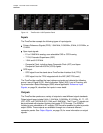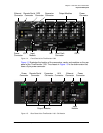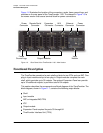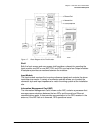
097-58001-02 Revision G – April 2008 TimeProvider User’s Guide 27
Chapter 1 Overview of the TimeProvider
NTP Operation
The NTP implementation in the TimeProvider supports full NTP server and client
mode operations, and works with or without GPS reference signals. The
TimeProvider supports the following NTP modes:
Mode 1: GPS available, Server mode – The NTP application defaults to GPS as
the master time reference; only NTP Server mode is supported.
Mode 2: GPS available, No Client mode – NTP Client mode is not supported
when GPS is available; only NTP Server mode is supported.
Mode 3: GPS not available, Client mode – When GPS is not available, the
TimeProvider will go into client mode to search for time references from
user-programmed timeservers with valid IP addresses.
The user can input up to eight IP addresses of other timeservers. If there are
multiple timeservers, the TimeProvider performs an ensembling of all the
timeservers to determine the system time based on the averaging of all the
valid timeservers. The user can also manually select which of the timeservers
available to be the prime. The user can set how often to request an update
from each individual timeserver from the eight IP addresses, ranging from 16
seconds to 1024 seconds, incrementing in powers of 2.
At any instance in client mode, the time reference within the TimeProvider is
totally derived from the ensembling of the timeservers, and is not reliant on
the IOC for time ticks.
Mode 4: GPS not available, Server mode – The TimeProvider can be enabled or
disabled for server mode operation. This mode is supported only when the Client
mode has found and validated the time stamp from the ensembling of the
timeservers.
MD5 authentication is included in the NTP implementation. The user can enable or
disable the MD5 feature, and is available in server and client modes. Client
configuration for MD5 operation requires Server IP, MD5 Authentication Key, and
Key ID.
The user can enter an MD5 Authentication Key of up to 32 ASCII characters that is
not case-sensitive. In addition, there is also a key ID ranging from 0 to 65534 in the
MD5 authentication process. When MD5 is enabled and a client requests NTP
information but the MD5 key cannot be authenticated or is missing the MD5 key
altogether in the request, then the TimeProvider does not process the client’s
request. The TimeProvider does not provide any response or events in these two
scenarios.
If MD5 is disabled, a client request is returned with the proper NTP time stamp
regardless of whether the client has an MD5 key attached in the request.


















